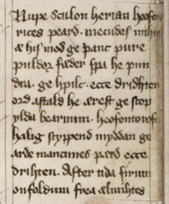Poem
f. 82r, outer margin

1Nupe[2] sculon herıan heofo〈n〉|
rıces[3] peard· 2mecudes míhte[4]|
æ[5] hıs mod ge þanc 3pure|
puldor· fæder spa he pnn|
dra·[6] ge hpılc· 4ecce drıdhten[7]|
ord astald 5he ærest ge stop[8]|
ylda bearnum· 6heofontorofe[9]|
halıg styppend[10] 7myddan ge|
arde mancımes[11] pærd 8ecce|
drıhten· After tıda 9fírum[12]|
onfoldum frea ælmíhtes[13]|